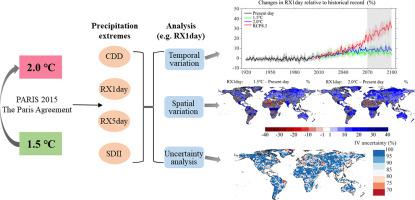Atmospheric Research ( IF 4.5 ) Pub Date : 2021-09-24 , DOI: 10.1016/j.atmosres.2021.105868 Jiali Ju 1 , Chuanhao Wu 2 , Pat J.-F. Yeh 3 , Heng Dai 4, 5 , Bill X. Hu 1, 6

|
To avoid more severe impacts from climate change, the Paris Climate Agreement strives to limit global warming to below 1.5 °C above the pre-industrial level. The large socioeconomic costs of extreme weather events make this target crucial for the impact assessments of 1.5 °C warming. Using four extreme precipitation indices, this study presents a global assessment of precipitation extremes projections under 1.5 and 2 °C warming targets based on the Community Earth System Model low warming (CESM-LWR) experiment. The uncertainties in precipitation extremes projections due to model internal variability (IV) and warming scenario (WS) are quantified by using the variance-based hierarchical uncertainty analysis. Results indicate that both warming targets are expected to exacerbate the extreme wetness events (RX1day and RX5day) and precipitation intensity (SDII) in most global regions, and to intensify the consecutive dry days (CDD) in tropical regions. The additional 0.5 °C warming will increase RX1day, RX5day and SDII over many global regions (e.g., northern high latitudes and central Africa), while decrease (increase) the frequency of CDD in northern high latitudes, central Africa, and eastern South America (in some arid regions and Amazon). Our uncertainty analysis indicates large spatio-temporal variability in the uncertainties of IV and WS. Overall, IV contributes to >80% of the uncertainties in all projected precipitation extremes and this contribution tends to diminish towards the end of this century at the interannual scale, while WS contributes to <20% of the uncertainties. IV (WS) uncertainty is the lowest (largest) in Greenland, northern Europe, Australia, northeastern and southeastern Asia, and Amazon.
中文翻译:

全球变暖目标在 1.5 °C 和 2 °C 时与全球降水相关的极端事件:基于 CESM-LWR 实验的预测和不确定性评估
为避免气候变化带来更严重的影响,《巴黎气候协定》力求将全球变暖限制在比工业化前水平高 1.5°C 以下。极端天气事件的巨大社会经济成本使该目标对于 1.5 °C 升温的影响评估至关重要。本研究使用四个极端降水指数,基于社区地球系统模型低变暖 (CESM-LWR) 实验,对 1.5 和 2°C 升温目标下的降水极端预测进行了全球评估。由于模式内部变异性 (IV) 和变暖情景 (WS) 导致的降水极端预测的不确定性通过使用基于方差的分层不确定性分析进行量化。结果表明,这两个变暖目标预计将加剧全球大多数地区的极端潮湿事件(RX1day 和 RX5day)和降水强度(SDII),并加剧热带地区的连续干旱日(CDD)。额外的 0.5 °C 变暖将增加全球许多地区(例如北部高纬度和中部非洲)的 RX1day、RX5day 和 SDII,同时降低(增加)北部高纬度、中部非洲和南美洲东部的 CDD 频率(在一些干旱地区和亚马逊)。我们的不确定性分析表明 IV 和 WS 的不确定性存在很大的时空变异性。总体而言,IV 对所有预测极端降水的不确定性的贡献超过 80%,并且这种贡献在年际尺度上趋于本世纪末减少,而WS贡献<20%的不确定性。IV (WS) 不确定性在格陵兰岛、北欧、澳大利亚、东北亚和东南亚以及亚马逊地区最低(最大)。











































 京公网安备 11010802027423号
京公网安备 11010802027423号